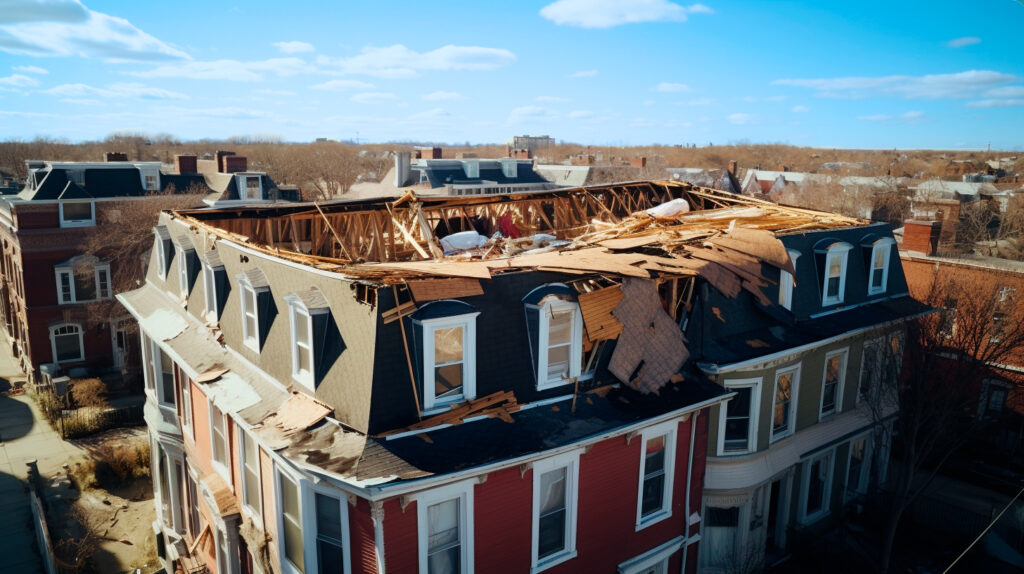How Often Should You Replace a Roof to Be Warm & Safe?
Reading Time: 5 minutesPoets might say that love lasts forever, but in the more practical realm of how often to replace a roof, everything has an expiration date. Thus, it would be best to consider your roof’s lifespan, provided you want to keep it securely over your head.
So, how often does one need to replace a roof? Let’s review the common signs of a roof’s inevitable aging.

Damage Assessment: Repair or Replacement?
Of course, installing a brand-new roof eats up a significant bulk of your budget. Therefore, many homeowners have a valid reason to postpone the process for as long as possible. Still, at some point, your efforts to patch things up will be as effective as trying to mend a broken leg with a band-aid.
Thus, it might be practical to learn to spot the cases when a complete roof replacement is preferable:
1. Life expectancy has reached limits, or there is too much damage.
- Everything has an expiration date. Hence, when your roof approaches the limits of its life expectancy, you’ll start noticing signs of decay, such as leaks, cracks, dark spots, missing pieces, moss, rust, or mold.
2. Sometimes, it is cheaper to replace the roof entirely.
- The general rule is that if roof repairs account for more than? Of roof replacement costs, you should save some money and opt for a complete renovation.

3. Improper installation.
- Essentially, you shouldn’t change an improperly installed roof right away. But its lifespan will be substantially shorter compared to the estimated one. Therefore, you might notice that it’s time to replace your roof just a few years after its installation.
4. It is your permanent home, and you plan to stay in it.
- There is nothing more permanent than the things people call temporary. Still, spending your savings on fixing your property is natural and pleasant. Thus, when you rent a house, it’s preferable to go with repairs. You can also consult the owners to see if they can present a mutually beneficial solution.
5. The house is for sale.
- Old roofs have lost their marketable appearance long ago. Meanwhile, a shiny new roof will immediately boost your home’s market value. As a result, you will have a smooth sale instead of a quest of searching for people who fancy a challenge.
How Often to Replace a Roof: Determinants & Statistics
So, how often do you need to replace a roof? To answer this question correctly, you should take multiple factors into account. Some of them depend on you, and some of them are out of your control. Yet, there are precautions that you can take to increase the longevity of your roof’s life.
Type of Roofing
Generally, every material endures normal wear and tear. Yet, some roofs you pass on to your grandkids, while others you might have to change before your kids graduate high school.
| Roofing Material | Expected Lifespan | Major Characteristics |
| Composition Shingle Roofs | 15–20 years | It is synthetic. Its resistance to any impact is impeccable. |
| Asphalt Shingle Roofs | 3-tab 15–25 years; Architectural and luxury ~30 years | It displays a perfect balance between durability and affordable price. |
| Wood Shake Roofing | 30–40 years | It has a considerable lifespan. Your home looks stylish with it. Maintaining it can be very challenging. |
| Metal Roofs | Stand seam metal roofing ~50 years; Ribbed metal panels, 25–50 years; Stone-coated steel tiles 30–50 years | They will serve you for a long time, especially if it’s a premium metal. |
| Clay Tiles | 50–100 years | High temperatures and rot pose almost no threat to them. You have to clean them frequently. |
| Slate Tiles | 75–200 years | They seem to be indestructible. They are incredibly low-maintenance. Their weight might be too heavy for your home. |
The Perks of Planning Beforehand
Now, you can calculate the approximate lifespan of your roof. Hence, you can start saving money in advance. Generally, when your roof’s age has reached the last quarter of its estimated lifetime, it’s time to add the replacement cost to your budget.
For example, you have a 3-tab shingle roof. Start saving money to install a new roof after 10 or 12 years. With this approach, you will be financially ready when the time comes.

Climate
People build houses to hide from rain, snow, sun, storms, and other uncomfortable weather conditions. Thus, walls and roofs take the brunt. As a result, they suffer from water damage, high winds, and extreme temperatures.
Word of Advice
Choose the materials wisely. For instance, clay tiles cannot survive the freezing and thawing of a cold climate. Cedar shakes withstand severe winds, which makes them perfect for coastal areas. Asphalt shingles crack after drastic temperature shifts.
Surrounding
Your house is an intertwined system. Plus, it exists in a broader environment. Hence, both inside and outside elements can affect the well-being of your roof.
Useful Tips
Pay extra attention to the spaces near the roof, like the attic or lawn:
✅ Ice, snow, branches, and leaves will inevitably have a detrimental effect on your roof.
✅ Check your attic’s ventilation and insulation. Inhibited air circulation and heat will eventually result in the roof’s deterioration.
Installation
Relying on a reputable roofing contractor for a roof installation guarantees that your roof will serve its time. But if you choose to do it yourself without proper skills or delegate it to an amateur to cut down expenses, your roof might fail you even before it reaches the peak of its estimated lifespan.
Maintenance
Of course, if you take proper care of your roof, it will reward you with a better condition. As a result, you can enjoy the benefits of:
- safety;
- energy efficiency;
- and pleasing appearance.
Important Reminder
A regular professional roofing inspection can increase the longevity of a roof and eventually save you money. Still, there are certain things that you can incorporate into your routine and avoid calling professional help:
- Clean your roof regularly. Slowly but surely, ice, snow, debris, moss, and leaves will cause trouble.
- Gutters should stay clear as well. Any impediment in the water runoff will result in a drainage problem.
- Fix minor issues before they turn into major ones. For example, do not delay replacing cracked, crooked, loose, or missing shingles.

Final Thoughts
Overall, if you strive to determine how often to replace a roof, you have many factors to consider. It might depend on the type of roofing material, weather conditions in the area, the amount of care you invested in keeping it in one piece, and the frequency of roofing inspections.
You can use the average numbers as a reference and start saving money a few years in advance. But you can also call for professional help for a more accurate assessment.
Denis is the driving force behind ID Flat Roof, a leading company in Boston specializing in flat roof repair and installation for over 20 years.
Expertise:
Denis excels in PVC, TPO, EPDM, and rubber roofing. His meticulous approach ensures quality and customer satisfaction.
Innovation:
Denis incorporates cutting-edge solutions like skylights and solar PV roofing.



